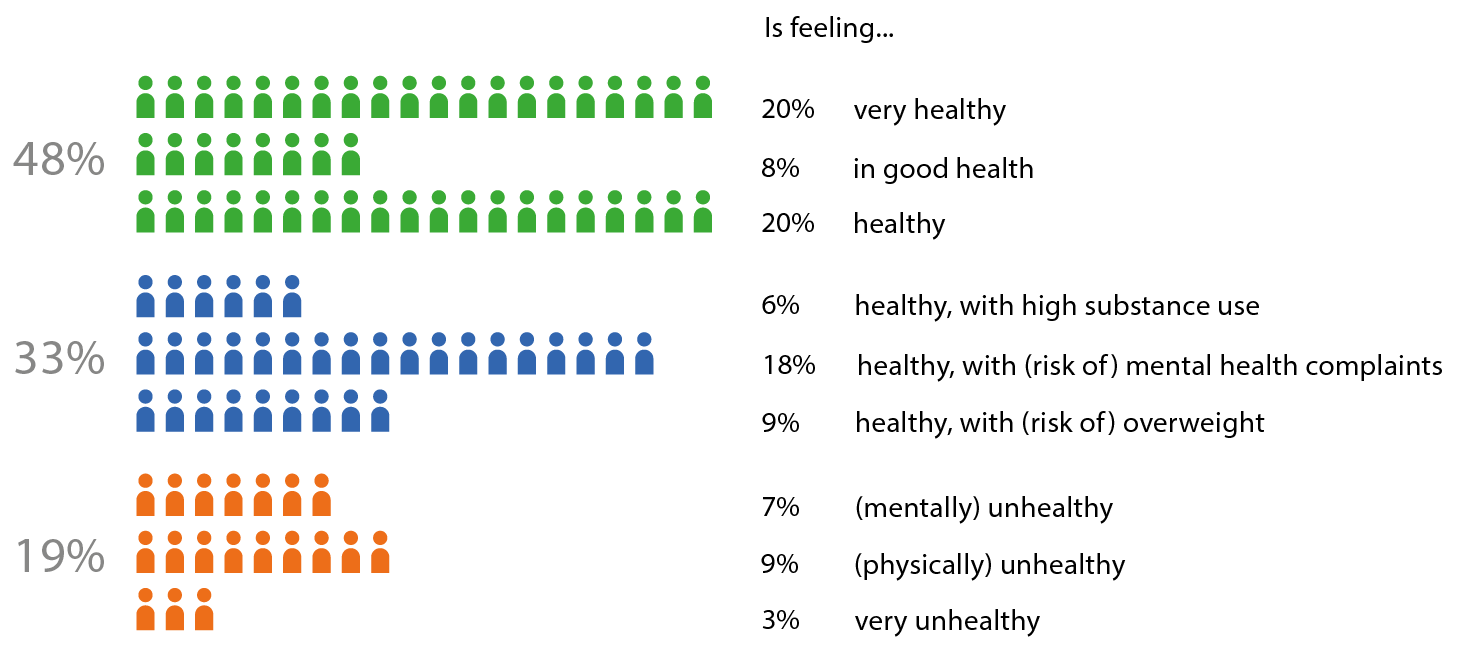Patterns in health
How health problems among Utrechters converge
Summary
This chapter describes nine health groups. Each of these nine groups of Utrechters has its own distinctive pattern of relationships between health and health risks. The health groups are based on research into how Utrecht adults (ages 18-64) experience their health. The nine health groups are divided into three larger categories:
- 48% feel healthy, experience few physical and mental health problems and have a predominantly healthy lifestyle
- 33% feel healthy but have health risks due to their physical or mental health problems or lifestyle
- 19% feel unhealthy, have health problems and a predominantly unhealthy lifestyle. This is nearly 46,000 residents, of which more than 7,000 residents (3%) feel very unhealthy. These residents score unfavourably on almost all aspects of health.
Figure 1: Percentage of adults in nine groups with characteristic health pattern

The group of Utrecht adults (19%) who feel unhealthy:
- Is less likely to have completed a college or university education
- Is more likely to have difficulty making ends meet
- Is less likely to be employed
- Is less likely to be satisfied with their home
These factors structurally affect the chances of healthy living. The chapter on livelihood security explores this in more detail. The 3% of Utrechters who feel very unhealthy are also more likely to have difficulty understanding written health information. They are also more likely to report that someone in their household did not receive care that was needed in the past year. In more than half the cases, this was because of cost.
This chapter shows what health problems and risks converge in the nine groups, how large these groups are and where they live in the city. This information helps guide (policy) interventions for greater health gains. For example, the Binnenstad and Oost districts have a relatively large group of younger adults with high substance use. The west side of Utrecht has a large group of Utrechters who feel healthy, but where overweight is a risk. And nearly a third of adults in Overvecht feel unhealthy, have health problems and a predominantly unhealthy lifestyle.
Conclusions and recommendations
Nearly 46,000 Utrecht adults (19%) feel unhealthy, have health problems and a predominantly unhealthy lifestyle. These people are also more likely to have problems with money, housing and work. These are factors that structurally affect the chances of healthy living. Improving the health of these people and reducing health disparities requires a comprehensive approach. That approach should focus on promoting people's healthy behaviours and skills, combined with efforts to address underlying causes of health, such as income, work, and housing (RVS, 2020). Reducing health disparities is thus an integral task, to which other tasks also contribute, such as work for all, growing in balance, strengthening resilience and care close by and tailored to the individual.
Over 83,000 Utrecht adults (33%) feel healthy, but have health risks due to their lifestyle or physical and mental health problems. A stable base around income, work and housing is also important for these people to stay healthy. Prevention by encouraging healthy behaviours or supporting physical and mental health problems when needed can further help ensure that these Utrechters continue to feel healthy.
All Utrecht districts are home to adults who feel unhealthy or have health risks. Differences do exist between districts in the proportion of residents who feel unhealthy or have health risks. So effort is needed in all districts, but some districts require more commitment or commitment to specific topics. For example, the Binnenstad and Oost districts have a relatively large group of younger adults with high substance use, and the western side of Utrecht has a large group of Utrechters who feel healthy but for whom overweight is a risk. Nearly one-third of adults in Overvecht feel unhealthy, have health problems and a predominantly unhealthy lifestyle. This makes Overvecht an important finding place to reach residents who feel unhealthy.
Accountability
This chapter is about Utrechters aged 18 to 64. This group is over 250,000 residents. 6,296 of them completed a questionnaire about their health. Static analyses were used to extrapolate the data for the entire group of Utrecht adults.
Utrecht's elderly (> 65 years old) are not included in this study. Patterns in health problems and risks in the elderly will be the subject of a special issue in 2023.
The proportion of adults who feel very unhealthy is most likely greater than 3%. People in vulnerable situations are less likely or unlikely at all to participate in written surveys. The health and living situation of Utrechters in a vulnerable situation is monitored separately by Meetellen in Utrecht.
The division into nine health groups and the correlation with factors affecting health is a simplified representation of a complex reality. In reality, the situation of individual Utrechters is unique. The health or situation of individual Utrechters will rarely exactly match the picture of the health groups.
